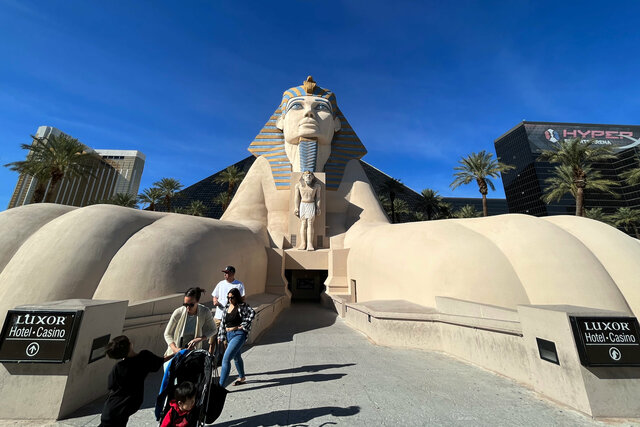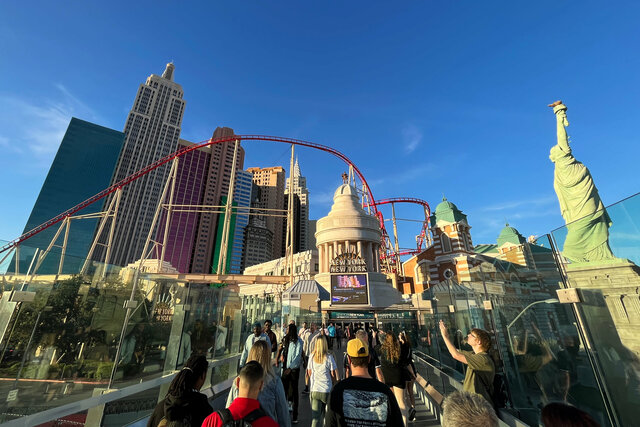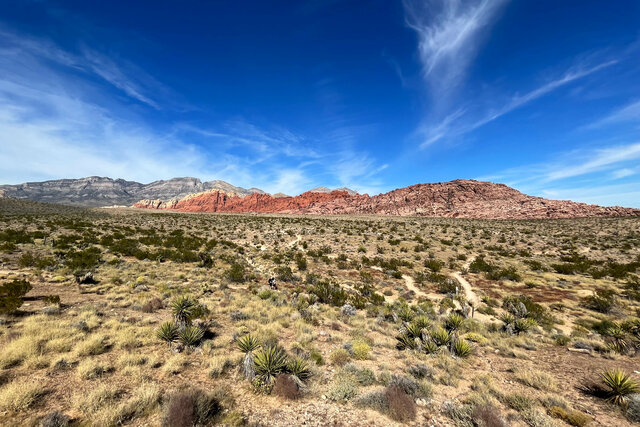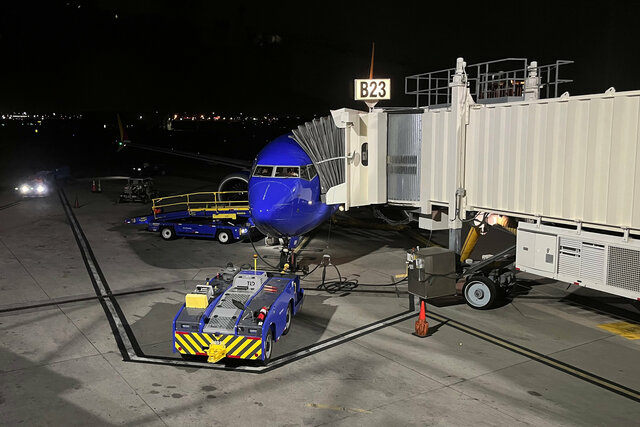Leaving Las Vegas
Started: 2023-11-15 20:27:23
Submitted: 2023-11-15 23:18:14
Visibility: World-readable
I suppose I ought to try gambling while in Las Vegas; then hiking, and an atomic testing museum, and a first flight on a new (cursed) aircraft type
Saturday, the 4th of November was my last day in Las Vegas. I picked an evening flight to give me a chance to see things in Las Vegas before I left.
This included taking the tram north from the Luxor, giving me one more chance to see the Egyptian-inspired decor as I waited for the tram.
I decided to spend my time gambling (just to say that I had done it, without expecting to get anything out of it) a few resort-casinos north on the west side of the Strip at Park MGM, which had a non-smoking casino floor, so I could indulge the vice of gambling without simultaneously indulging in other people's second-hand smoke. I fed $5 into a slot machine and promptly lost it on the first spin, then set the machine to tiny bets and lost the next $5 somewhat more slowly. I wasn't sure what I expected, but it was barely even fun.
I was amused that the cash-out button on the slot machines played a recording of coins falling into a bucket when it printed out the cash-out voucher, which I could take to another slot machine or the cashier. (I kept mine as a souvenir of my visit to the casino floor.)
Most of the tables with card games were playing blackjack, which I understand just barely well enough to know I'm not very good at playing it. I lingered at a roulette table and tried to figure out how the players sitting around the table were picking their bets. When the ball settled on one of the spots on the wheel the dealer swept most of the color-coded chips into a hole in the corner of the table, then paid off the bets that made money. None of it looked especially fun unless one happened to get lucky.
I don't believe in luck in cards or dice or slots; on average the house always wins, and I assume I'll be unlucky on average.
I left the Strip behind and drove west out of town into the foothills on the far side of the valley to Red Rock Canyon, a National Conservation Area operated by the Bureau of Land Management. The centerpiece of the area is a several-mile-long one-way scenic drive; to enter the drive I had to reserve a timed ticket in advance (which led to my somewhat-awkwardly-timed jaunt up Las Vegas Boulevard to Park MGM ahead of my one-hour-wide timed ticket to enter the drive).
I looked around the visitor's center before setting out on the scenic drive itself and noticed that the surrounding desert looked (relatively) green. This looked like the result of Hurricane Hilary bringing water to the desert in August.
On the drive I had the idea that I wanted to some light hiking on the trails departing from the road, but I didn't take the time in advance to figure out what I wanted to see. I made two loops of the Sandstone Quarry parking lot before giving up on finding a space, then dropped by the overlook at the highest point on the road before parking at the Petroglyph Wall Trailhead along a road leading off from the main loop. i parked at the end of the paved road; a four-wheel-drive road led further into the hills, and there were a number of four-wheel-drive vehicles parked by the side of the road with tiny portable air compressors inflating their tires to the appropriate pressure after navigating the road.
I followed the trail to the petroglyph wall, located on the side of the canyon where there were a series of markings scratched into the weathered rock, partially hidden behind the brush growing along the base of the wall.
I took a short, a one-mile-long loop trail down one side of the canyon and back up the other side. I started out in full sun; it was warm but not too hot, even though it was the beginning of November. (I guess I should be glad I waited until November to visit, when the weather had cooled down from the heat of the summer.) On the return the trail crossed to the side of the canyon cast in shadow by the rock walls. I followed the trail to a dead-end where a tiny trickle of water dripped from a rock suspended above a cliff, vaguely resembling a waterfall.
I returned to my car and completed the one-way loop of the scenic drive (past a large emergency response at a trailhead further down the loop), then turned back onto the two-lane highway running past the conservation area to head back to Las Vegas.
The last thing I wanted to see in Las Vegas before heading to the airport was the National Atomic Testing Museum, located on the ground floor of an office building on the edge of the University of Nevada, Las Vegas. This museum covered the atomic tests conducted in Nevada after the Second World War up until the end of the Cold War.
The first thing I saw in the lobby was a ballistics case for a "Fat Man" bomb, the plutonium warhead detonated over Nagasaki.
In addition to the test sites itself, the museum covered the Atomic Age, including a display containing a series of artifacts from popular culture in the 1950s inspired by the atomic bomb.
One of the weirdest and most chilling photographs shown in the museum showed a mushroom cloud from the Nevada test site visible from the casinos and hotels on the Las Vegas Strip in the 1950s.
The US switched from atmospheric testing to underground testing to reduce the risk of fallout, then pushed test ban treaties to convince the Soviet Union to do the same. The museum dedicated the middle section to underground testing. Early tests were conducted in caverns dug into the rock, which allowed recovery of some of the monitoring equipment after the blast. The exhibits answered my question about what actually happens with the rock in an underground blast: it vaporizes, then condenses and cools and solidifies, and ends up denser than before (as a sort of metamorphic rock), causing the ground above it to collapse in a subsidence crater. The easiest sort of underground test to perform is in a vertical shaft, but the explosion causes the shaft and any equipment in it to be destroyed. The only way to get any data out of the shaft is to design the monitoring equipment to stream its telemetry in the brief time before it's vaporized.
The last section of the museum talked about what has happened with nuclear testing since the Comprehensive Test Ban Treaty, including subcritical experiments to check the status of the current nuclear stockpile (although reduced in number from its Cold War peak, we still possess enough nuclear weapons to annihilate humanity by more orders of magnitude than I care to look up).
One of the last exhibits in the museum was the casing from a B-53 thermonuclear weapon, a high-yield 9 megaton bunker-buster decommissioned and disassembled in 2011. This was a weapon of mass destruction capable of destroying an entire large city in a single explosion.
One thing I found interesting in the museum was the tone it used to present the atomic testing program. Several videos throughout the museum included interviews with people involved with the program who expressed pride in their role in the testing program and the role they felt they had in winning the Cold War. The museum only really attempted to present a slice of the story, focused on the testing itself, without considering in detail the greater context of the American nuclear weapons program and its role in and beyond the Cold War. Any broader view would have to consider unknowable counterfactuals, which this museum didn't consider.
I left the museum and headed down the street to the fast electric charging station in front of Target, where I first charged my electric rental car the day before. It wasn't clear how much charge I was expected to return the car with, especially since I received the car with a 35% charge. After driving to Hoover Dam yesterday and Red Rock Canyon today I had run the battery down to the same charge. I had some time before I really needed to get back to the airport, so I figured I might as well charge the battery, at least for the person who would drive the car after me, if the rental car agency failed to charge it themselves. I spent about 25 minutes charging and got the car up above 60% and called it good.
When I booked my flight home from Las Vegas, Southwest indicated that I would be flying on an older 737-800 aircraft, but when I reached the airport, my aircraft had transmuted into a 737 MAX8. I had not yet had the chance to fly on a 737 MAX, after it was grounded following two crashes early in the aircraft's operating history caused by the MCAS system. (MCAS itself was a hack, allowing Boeing to convince the FAA that the 737 MAX was really the same aircraft as the first 737 to roll off the assembly line 50 years ago.) The long process of reinstating the aircraft into service gave me plenty of time to think about how safe I felt flying on this cursed aircraft. The answer I came up with (back when the aircraft was returning to the skies, long before I thought about booking a flight on it) was: any further incident involving MCAS on a 737 MAX would be devastating to the institutional credibility of Boeing, the FAA, and the airlines. Boeing ought to have done an internal soul-searching to make sure there were no more lingering design flaws in the aircraft. The FAA, I hope, had the leverage it needed to claw back certification from Boeing. The airlines put their crew's lives on the line. Another crash (or even an incident) would be a massive shitshow, spawning lawsuits and congressional hearings and ending careers. And that, I think, is the right motivation to scare everyone into doing the right thing (never mind that they should have been doing the right thing all along and failed).
So I walked onto the 737 MAX in Las Vegas confident that the odds were in my favor that I'd walk out again in San Jose.
When I boarded the aircraft I checked the safety information card, under the weird all-blue-light color scheme the cabin crew had apparently selected for the boarding process.
Aside from the cabin lighting scheme, the short flight back to San Jose was pretty much like every other short Southwest flight I've flown from a middle seat. We landed in San Jose on schedule and I drove back home across the mountain to Santa Cruz, after a short and memorable weekend trip to Las Vegas.












